New to sourdough bread? Here’s an easy Sourdough Bread recipe with thousands of success stories! Includes easy step-by-step instructions, videos, expert tips, and everything you need to master sourdough bread baking!
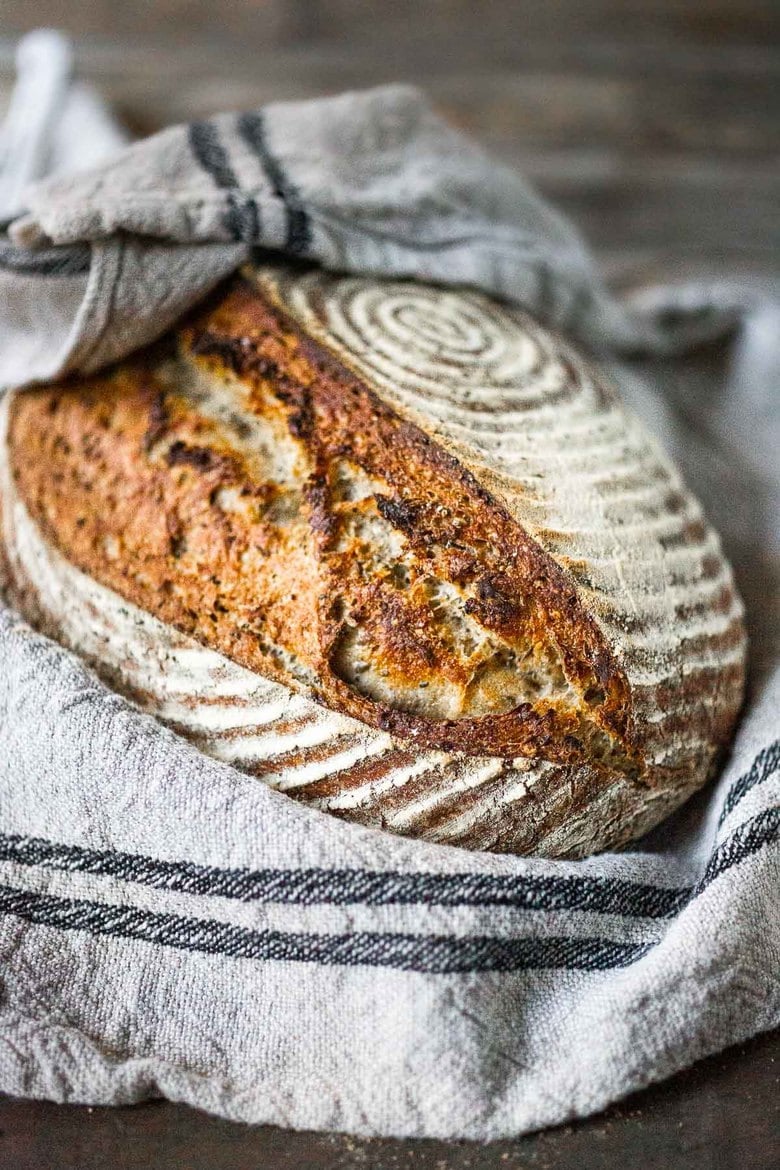
Are we free enough to open to the flow, no matter what it may contain?
Dorothy Hunt
With over 1400+ 5-star reviews, this sourdough bread method will guarantee success on your very first try! We’ve simplified our sourdough baking process to the most basic techniques. We show you the fundamentals. Most readers have success with their very first loaf. Just read the reviews!
Last week, I shared my recipe for a simple Sourdough Starter. Now, your starter might be ready to bake, so I want to share an easy, beginner’s recipe for no-knead sourdough bread that my friend Bee (from H is for Love) taught me over 12 years ago! I’ve been perfecting this method ever since, and it has proven to be truly foolproof.
This Sourdough recipe is flexible and easy, but most importantly, it works with my schedule. It doesn’t require much hands-on time- although there is a tiny bit, just enough to make it feel wonderfully gratifying. The sourdough is made the night before and rises overnight on the counter (10-12 hours), before it is baked in the morning. Because my schedule allows me to be home in the mornings, this bread really works well for me. Inversely, you can mix the dough early in the morning and bake it that night. It’s very flexible and forgiving, too- even when you think you messed it up, it manages to surprise you with a beautiful loaf.
TIP: When searching for a Sourdough Bread Recipe (there are many!), the key is to choose one that fits your schedule. This allows you to easily incorporate bread-baking into your week without adjusting your plans. Always consider the hands-on and proofing times (usually two) to ensure it suits your schedule and lifestyle.
What Our Readers are Saying
One reader, Nidhi Vaidya says: “This recipe has never failed me! It always produces a beautiful loaf. Whenever a friend says they want to start sourdough, I point them this way.” ⭐⭐⭐⭐⭐
️Stephanie says: “This recipe is perfection! Easy to follow and fool-proof! I love to cook and have never been much of a baker and never made bread! I dislike store bought bread and am excited to make this wholesome bread weekly! “⭐⭐⭐⭐⭐
Ann says: “My previous attempts at sourdough were big fails, but I tried out this recipe and my sourdough loaf is picture perfect and delicious.” ⭐⭐⭐⭐⭐
Table of Contents
- But First, What is Sourdough?
- Why you’ll love this Sourdough recipe!
- Sourdough BreaD Video (start-to-finish)
- Homemade Sourdough Bread Ingredients
- How to use Sourdough Starter
- Sourdough Baking Schedule
- How to make Sourdough Bread (Step-by-Step)
- Stretch & Fold Video (Technique #1)
- Stretch & Shape Video (Technique #2)
- Sylvia’s Expert Tips for Sourdough Bread
- Trouble Shooting Sourdough Bread
- Sourdough FAQS
- Practice Makes Perfect!
- More sourdough recipes you’ll love!
- More from feasting at home
- Easy Sourdough Bread Recipe with Starter
But First, What is Sourdough?
Sourdough bread is made using a natural leavening process that doesn’t need commercial yeast. Instead, it uses a “starter,” a mix of flour and water that ferments with wild yeast and good bacteria to help the dough rise. This fermentation not only causes the dough to rise but also gives sourdough its tangy flavor and chewy texture. Because sourdough is fermented and has no preservatives or additives, sourdough bread is easier to digest than store-bought yeasted bread, making it a healthier option!
Why you’ll love this Sourdough recipe!
- Easy Schedule: Make the dough the night before, proof it overnight on the counter (10-12 hours), and bake it in the morning. (Alternatively, the dough can be made in the morning and baked at night). It’s very flexible and can be placed in the fridge if something comes up, and you can’t bake in the morning, slowing the process down.
- Our Simplified Process: We’ve removed all the fussy, complicated processes that intimidate beginners from even starting. It is simplified down as much as possible while still producing a beautiful loaf! This sourdough bread requires no kneading and no fussing- it couldn’t be any easier to make with several basic techniques that anyone can do- see all 3 videos!
- It’s healthier than regular bread– sourdough contains no additives, preservatives or commercial yeast, and because it undergoes a fermentation process- it is easier to digest. Using organic flour ensures your bread is free of harmful herbicides often sprayed on wheat.
Sourdough BreaD Video (start-to-finish)
This 16-minute, step-by-step video will show you how to make sourdough bread from start to finish, with me walking you through it personally.
Don’t see the video? Allow 15-20 seconds to load it right here. If still not showing, check that your ad blocker is off, refresh the page, or try a different browser.
***Scroll down to the recipe card for clear, detailed instruction
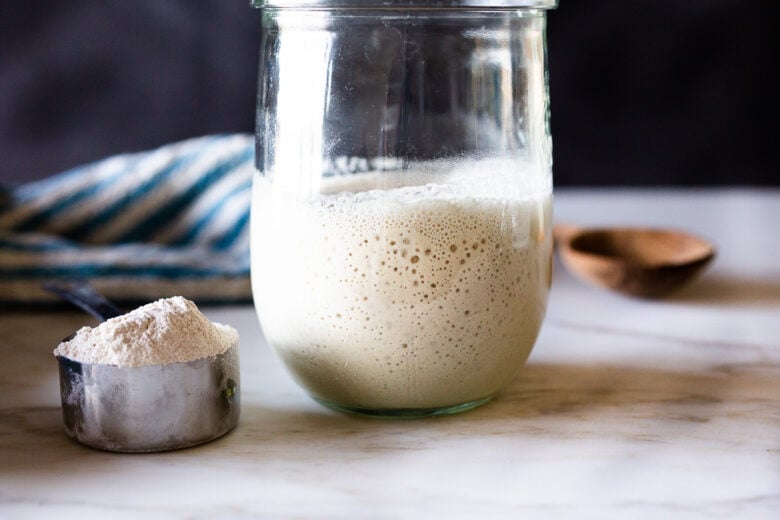
Homemade Sourdough Bread Ingredients
- Sourdough starter – You can make sourdough starter at home (it takes 5-8 days) or purchase it here. To maintain it, store it in a jar in the fridge and feed it, like a pet. 🙂 Yes, you can even name it. If properly fed and cared for it can live for hundreds of years! My starter is called Vita.
- Bread flour – try to use organic bread flour, if possible. All-purpose flour works in a pinch, but bread flour produces a better loaf.
- Water– use tap water, filtered water, or mineral water. Distilled water lacks minerals so don’t use that.
- Salt– fine sea salt or Himalayan pink salt
- Optional extras: rye flour, fennel seeds, caraway seeds, chia seeds, rice flour
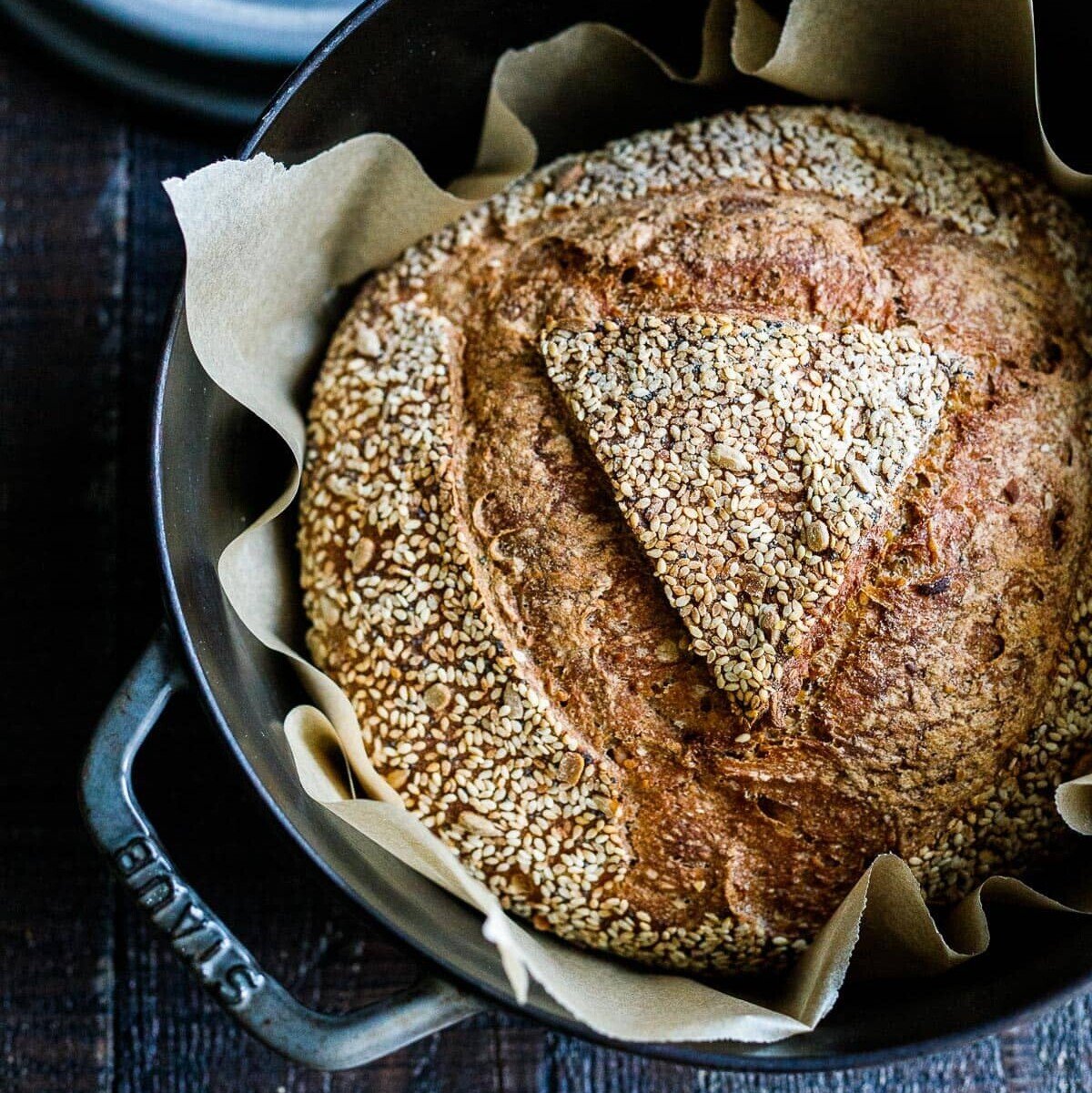
Baking Tools
After leaving all my favorite bread “gear” at home, it was a fun challenge to see if I could make bread with just the basics. Here is what you absolutely need:
- A Dutch Oven – I use and love this 5.5 Quart Staub Dutch Oven because of its metal knob and dark interior (it’s easy to keep clean). But something as simple and inexpensive as this cast iron dutch oven will work. Here are my favorite Dutch Oven picks for Bread baking! 4 ½ quart to 6-quart dutch ovens work well.
- High-Temp Parchment Paper- this “If You Care” Parchment Paper does not burn!
- A large bowl- glass or ceramic mixing bowl
- Measuring cups
- Kitchen towel
- Sharp knife, razor blade or scissors
- kitchen scale
- Thermometer
Here are some optional extras that make this more fun:
- Rice flour (for dusting)
- dough whisk
- Banneton (proofing basket) 9-10 round
- dough scraper
- Lame (scoring blade)
- Oven thermometer (to double check your oven is calibrated)
We offer this Sourdough-Making Kit at our Bowl and Pitcher Shop if you are interested.
How to use Sourdough Starter
- Be sure your sourdough starter is active and happy! It should double in size within 6-8 hours of feeding. If it is not doubling isn size, it will not rise your bread. For sourdough starter troubleshooting, please visit our sourdough starter post.
- When making sourdough bread, use a starter either right at it’s peak, or after it has peaked.
- For a more “sour” taste, use a starter that is “hungry”, and hasn’t been recently been fed.
Sourdough Baking Schedule
Keep in mind that rising time is affected by weather and seasons. In winter, cold kitchens will lengthen the rising time. In summer or warm weather, hot kitchens will shorten the rising time. So this is a rough estimate based on 70F weather
- Morning (6 am to 10 am) Feed the sourdough starter. 8-12 hours before you plan to mix up the dough, feed your starter, allowing time to peak before using. (Or feel free to use an unfed starter for a more “sour taste”, straight from the fridge at 8 pm)
- Night (8 pm- 10 pm) Mix the dough. Do two sets of stretch and folds, 15 mins apart (see 1st video)
- Proof Overnight. Cover the dough, let it proof (rise) overnight 8-14 hours at 65-70F on the kitchen counter.
- Next Morning (6 am-10 am) Shape and Bake. Check your dough when you awake, and when it has almost doubled in size, stretch, fold, and shape. ( Watch 2ndVideo ). Place in a parchment-lined bowl seam side down. Place this in the fridge for 1 hour while you preheat the oven.
- Bake 20-25 minutes (or until internal temp reaches 200F). Remove lid, and bake 10-15 more minutes, until very deeply golden and internal temp reaches 208F. Let it cool on a rack before cutting.
How to make Sourdough Bread (Step-by-Step)
***Scroll down to the recipe card for concise measurements & instructions.
Step one: Feed the starter in the AM.
Feed your sourdough starter in the morning 8-12 hours before making your bread dough -leaving it out on the counter and using it slightly after it peaks. Always use a slightly “hungry” starter. TIP: You know your starter is active and healthy if it doubles within 6 hours of feeding. In the evening, make the dough, after the starter has peaked.
Step Two: Weight the flour.
In a large bowl, weigh bread flour (520 grams) using a kitchen scale- being careful not to include the bowl’s weight. Here I’m using roughly 4 cups of flour, spooned and leveled. (3 1/2 cups of organic white bread flour plus a 1/2 cup rye flour.)
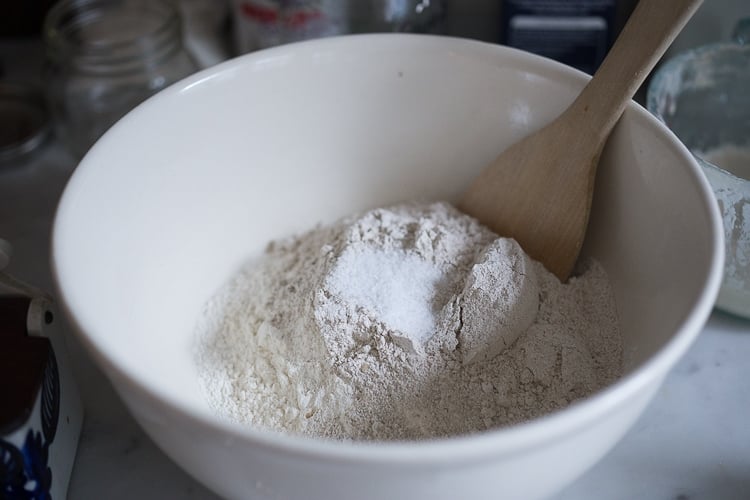
THEN Add 2 teaspoons salt and seeds if you like- here I’ve added 1 tsp fennel seeds, 1/2 teaspoon caraway and 1 tablespoon chia seeds.- I love this combination. Yes, you can add other spices and seeds. Get creative, but for the first loaf, I suggest going easy.
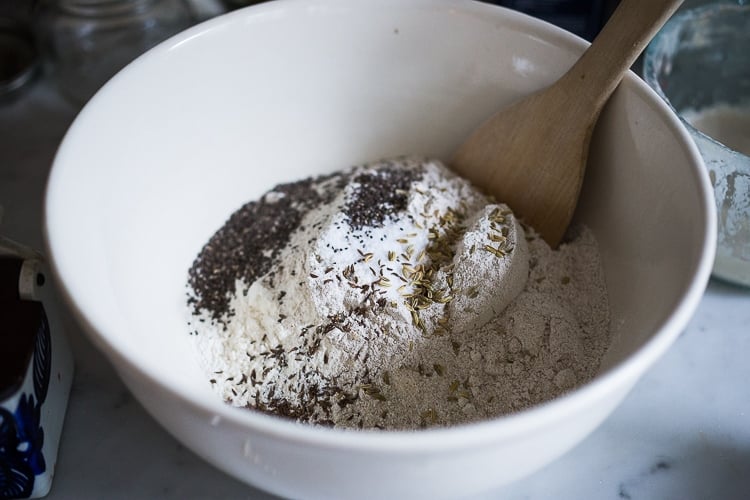
Step three: Mix the starter with water.
Stir down the starter, then mix 1/3 cup of sourdough starter (90 grams) with 1 3/4 cups water (385 grams) using a fork.
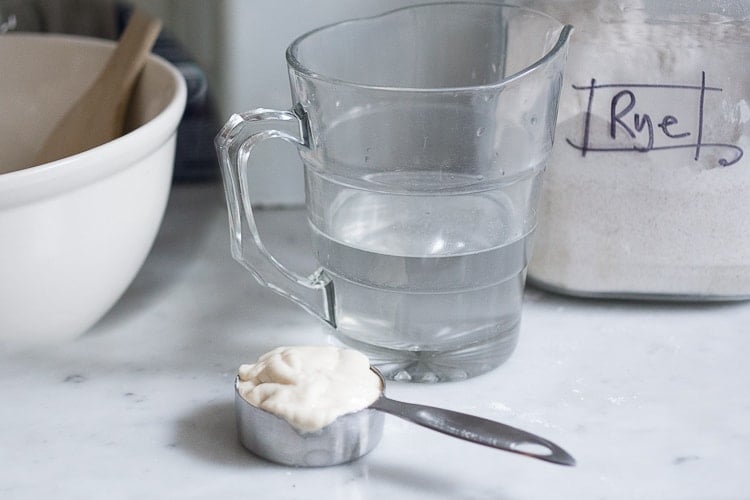
It will look like cloudy water.
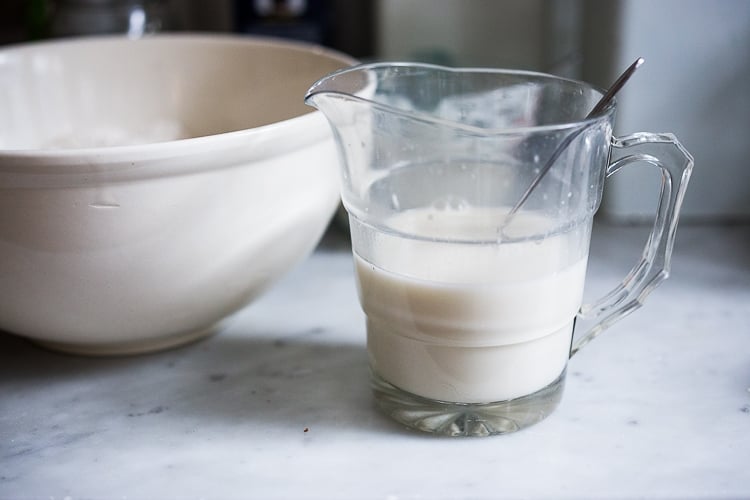
Step four: Mix The Dough (wet and dry).
Pour the starter/water mixture into the flour mixture and stir, using a fork, into a thick, sticky ball. Switch to a wooden spoon. Mix the dough for one minute to incorporate all the bread flour, using the wooden spoon. Just try your best to incorporate all the flour.
It will be thick, shaggy, and hard to mix. If the flour absolutely won’t mix in, then add a tablespoon of water at a time to incorporate it. Sometimes whole grain flour is “thirstier” than white flour, so you may need a little more water, a tablespoon at a time.
The dough will be heavy, thick and sticky (see photo below) to begin with, but will loosen up as it rests. Cover with a damp kitchen towel for 15 minutes, letting the dough rest.
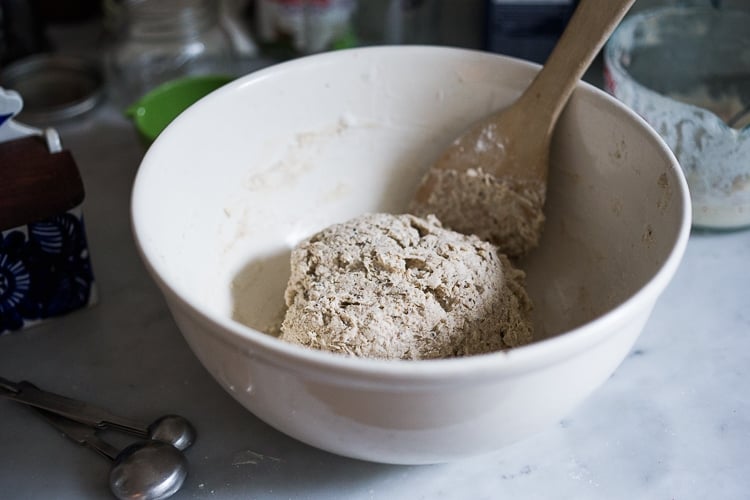
Step five: STRECH & Fold (video)
Do two “stretch and folds” sets to help build the gluten. Do this twice, 15 minutes apart. Watch the first video below. With wet hands, stretch and fold. Let dough rest 15 minutes covered, then repeat.
Stretch & Fold Video (Technique #1)
Don’t see the video? Allow 15-20 seconds to load it right here. If still not showing, check that your ad blocker is off, refresh the page, or try a different browser.
STEP SIX: PROOF THE DOUGH overnight
Cover the bowl with a damp kitchen towel (wet it thoroughly, then wring it out) and let the dough rise on the kitchen counter overnight 8-12 hours, at room temperature. This is called the bulk fermentation. Every environment is different, and seasons will affect the rising time. Warmer homes proof much faster, colder homes, much slower. In midwinter in the Northwest, I’ve even proofed for as long as 18 hours on the counter. Here in Santa Barbara, in summer, the dough was ready in 8 hours.
TIP: You can’t always look at the clock; you MUST look at the dough. It should be slightly domed, springy, slightly jiggly like a happy, full belly, almost doubled. Shake the bowl look for a bit of jiggle.
Do the poke test: Carefully poke the dough with a floured finger, 1/2 inch deep. If it is easy to indent, and the dough springs back, this is a good sign it has risen enough. If the dough feels very firm and hard to indent, it probably needs to proof longer. If the dough doesn’t spring back, holding the indentation, or feels overly soft, liquidy or loose- it is probably over-proofed. Don’t toss it. You can still bake it but will not rise as much in the oven and will be harder to handle. Put it in the fridge to firm it up a bit before doing the stretch and fold. You may still get an OK loaf. Hard to tell.
PREPARE the SHAPING BOWl: Place a piece of parchment in a bowl. I like using a high-sided medium-sized bowl versus a flat or shallow bowl, to help shore up the sides.
NOTE on Parchment: I use this parchment brand. It doesn’t stick or burn. If unsure about yours, spray your parchment with a little oil to prevent sticking.
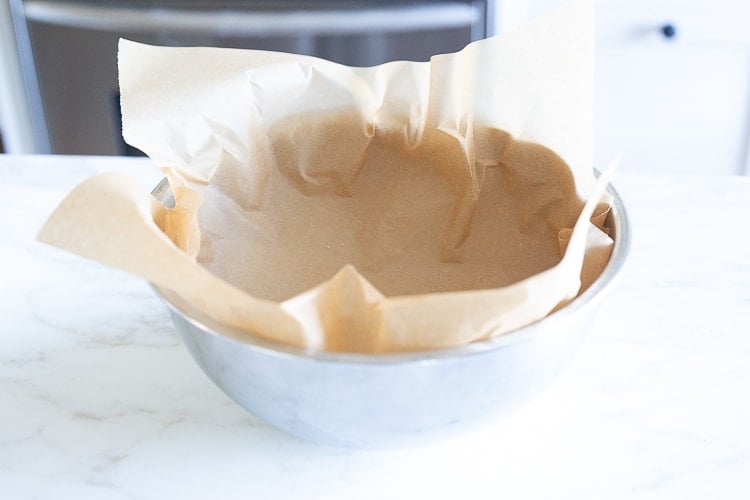
As you progress in your baking journey, you may want to use a Banneton (bread-proofing basket below). If using a Banneton, flour it well (rice flour works best here) and place any seeds on the bottom, placing dough seam-side up.
I will say- if starting out, it can be a bit tricky to flip the Banneton into the hot dutch oven, and have it land centered. I prefer to flip it onto parchment, score, then place the parchment and dough into the hot dutch oven. Up to you.
With using a piece of parchment paper in a regular bowl, there is no flipping, just lifting by the parchment and placing it in the dutch oven. Much easier!
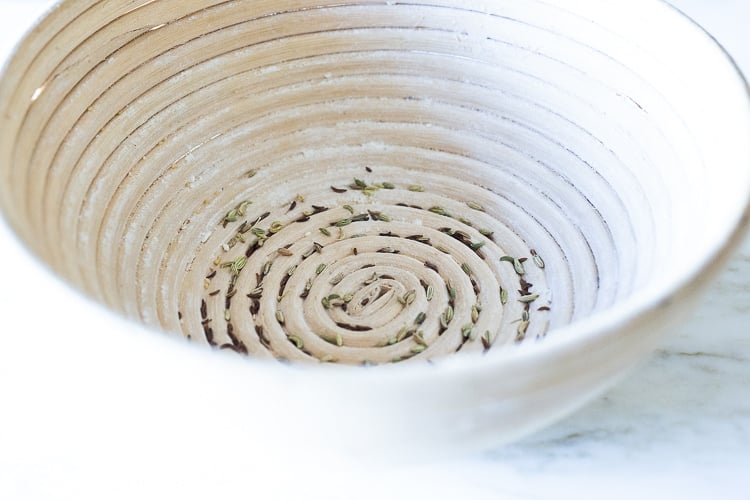
STEP 7: STRETCH and SHAPE (Video).
Watch the 2nd video below for a different “stretch and shape” technique to use AFTER the dough has been proofed. Loosen the dough from the edges of a bowl with a wet spatula or wet plastic dough scraper, sliding it down the sides of the bowl.
With wet hands, carefully pull the dough up on each side, lift it up about 1-2 feet high, and place it back down, folding it on top of itself gently.
Wet your hands again and give the bowl a quarter turn and do this again. (You could repeat this 20 minutes later) Then the 3rd time you lift and stretch, you will either lift it all the way up into your parchment-lined bowl seam side down. (EASIEST) or into the floured proofing basket, seam side up (pinching it closed).
Stretch & Shape Video (Technique #2)
Don’t see the video? Allow 15-20 seconds to load it right here. If still not showing, check that your ad blocker is off, refresh the page, or try a different browser.
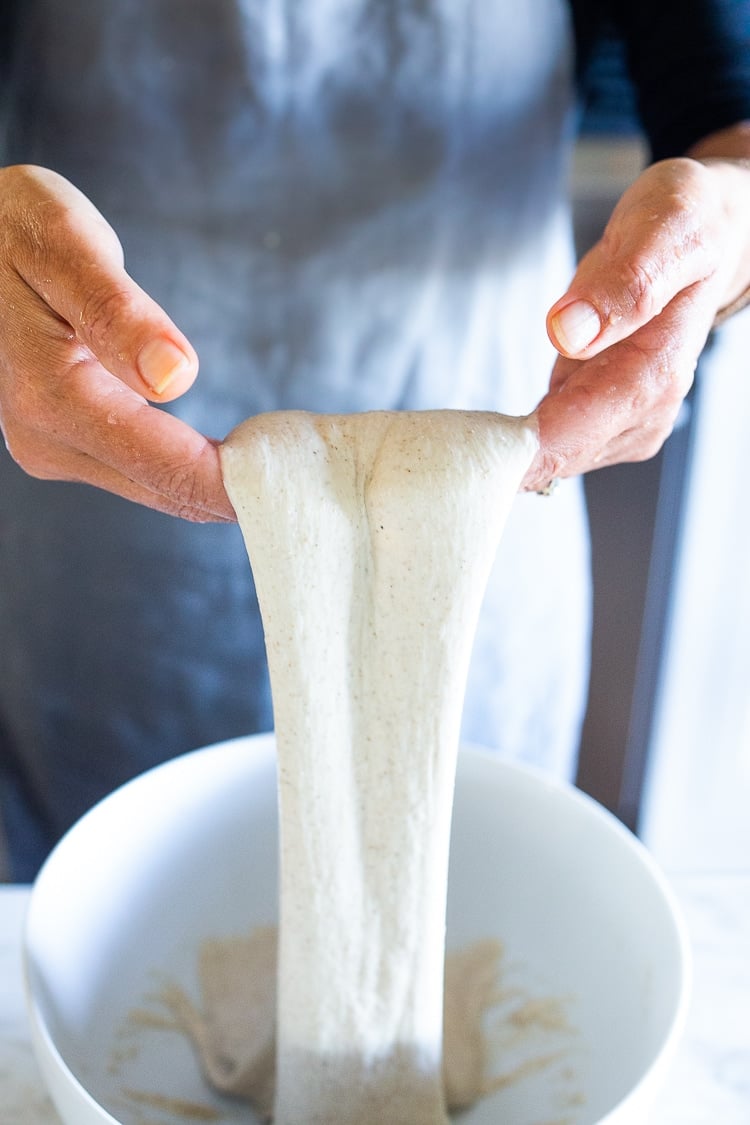
As you see above, after proofing the dough overnight, it will become much looser. The starter has metabolized the flour overnight. This can be tricky to handle. BUT, using wet hands and learning the 2nd stretch and shape technique in the second video above, will make the wet dough much easier to handle. Trust me here. 🙂
After the second set, lift the dough into the parchment-lined bowl. Many sourdough recipes call for placing the dough on a work surface to shape it, creating surface tension- we are skipping this step and using this stretch and shape technique instead- just to keep it simple.
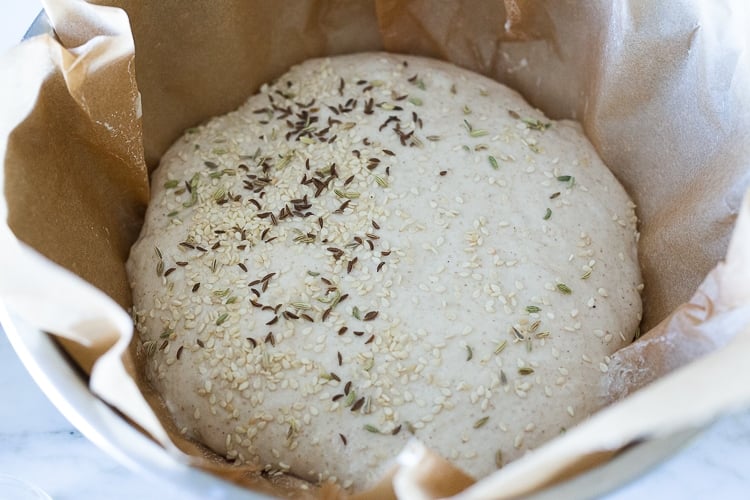
Sprinkle the top of the dough with seeds and dust with flour or rice flour (which makes it easier to score)especially if using the banneton, get those sides sprinkled well- so it flips out without catching!
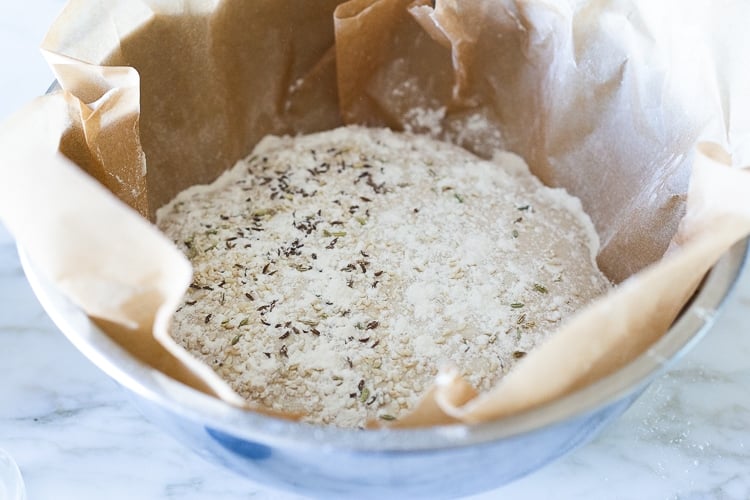
STEP 8: Second “RISE” and PREHEAT OVEN
Place the dough in the fridge for one hour (or up to 3 hours) while you heat up the oven to 500F with your Dutch oven inside (please see notes) for 60 minutes. Chilling the dough will make it easier to score and give it a little more “oven spring”. It is not intended to rise here.
STEP 9: SCORE & BAKE the sourdough
Score: Grease your blade or lame, and score the dough swiftly and deeply, at a 45-degree angle, 3/4 inch deep. Score where you want the dough to puff up. You can do one simple slash, a crescent, or a crisscross, or feel free to add other designs. (Just google sourdough scoring designs and be mesmerized for hours!) Oiling the knife helps. The lame really does make this 100 times easier!
Carefully take out the dutch oven from the oven and close the oven door. Remove the lid. Gently lift your dough holding onto the parchment corners, and lift it into the dutch oven, and quickly cover.
Bake: Place in the middle of the oven for 18-22 mins. Remove the lid; it should be nicely puffed, lightly golden, and around 200F. This is your goal. Continue baking 10- 15 minutes until deeply golden and internal temp reaches 208F. Please try to get your loaves crusty and deeply golden. Let them go a bit longer than you might think. 🙂
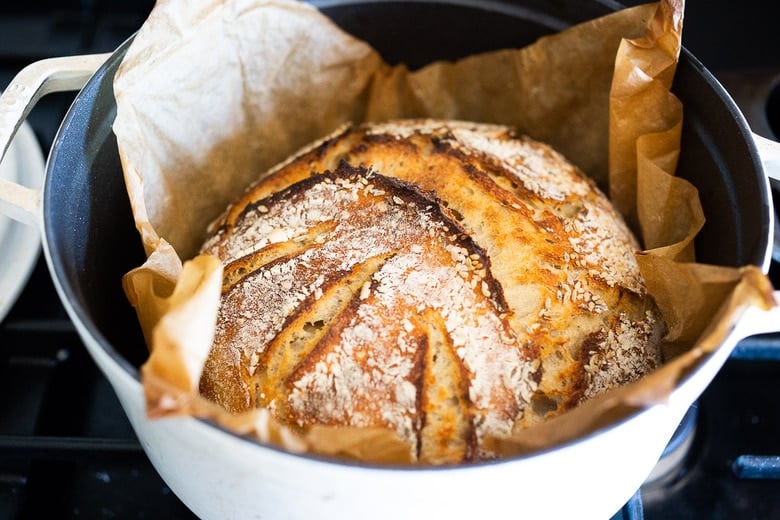
Pull it out, place it on a rack and let it cool before cutting. The HARDEST part! 😂
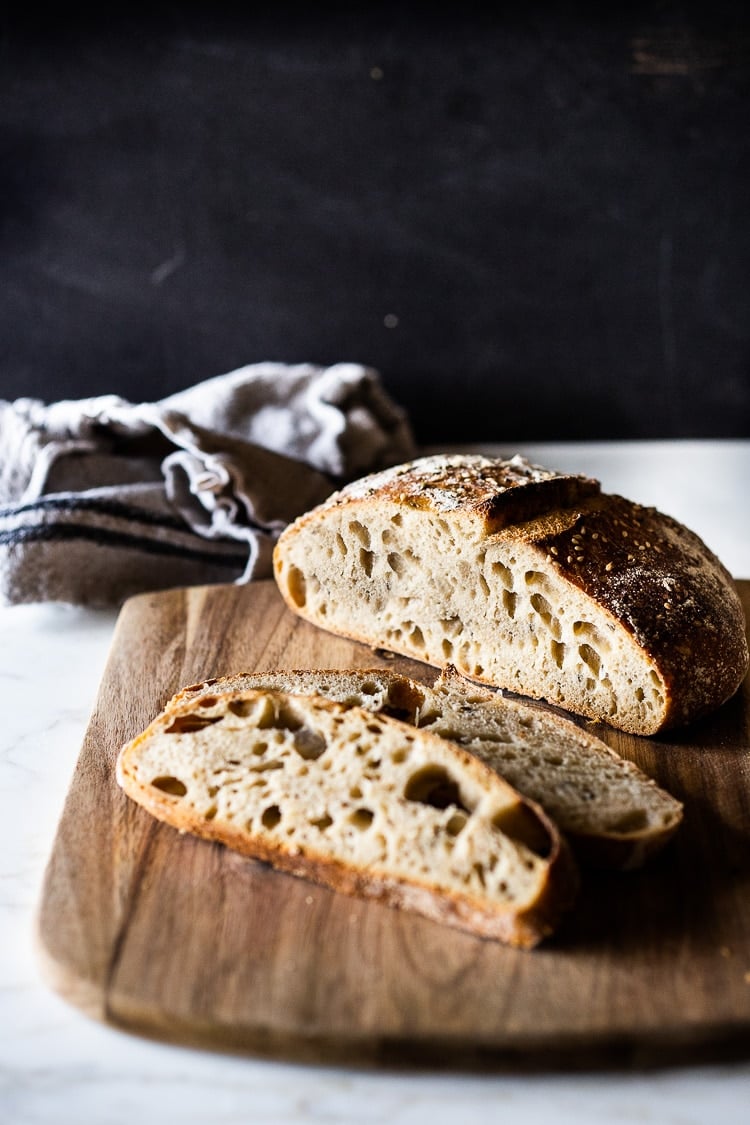
It will smell heavenly and you will feel proud. Bask in it! It truly is an accomplishment!!
Sylvia’s Expert Tips for Sourdough Bread
- STARTER: Using your starter slightly after its peak will ensure your bread rises sufficiently. Make sure your starter is healthy, strong and “hungry”, and doubles in size 6 hours after feeding. If you like a more “sour” taste, use an un-fed starter that has been stored in the fridge 5-6 days- and use without feeding it first.
- FLOUR: For your very first loaf, I highly suggest just using Organic White Bread Flour and be sure to weigh it. ***Please “zero out” the weight of the bowl. Weigh the flour without salt, seeds, or other additions. Try substituting a 1/2 cup of flour for another kind. For example, 3 1/2 cups white bread flour, plus 1/2 cup rye or whole wheat. If you add more whole grain than that, your loaf will be quite heavy and dense. I really don’t want this for your first loaf and neither do you. You want it to be amazing so you feel inspired to make it again and again. So be patient. After several practice loaves- yes, fiddle with other flours as much as you like!
- WATER: (Hydration) A wet dough will produce a lot of beautiful air pockets but it is much harder to work with, in the beginning. A dryer dough will yield a slightly denser, less airy loaf but will be easier to work with, in the beginning. This one falls towards the later – at 75% hydration- but you can easily adjust this down the road, as you practice, by adding a little more water or less flour in the initial mixing stage. To calculate the hydration level, you divide the water grams by the flour grams. In this case 385 divided by 520 = .75 or 75% hydration. As you get more comfortable, try for 80%-85% hydration, adding in a few extra folds at both stages.
- ADDITIONS: If you want to start adding things to your bread- nuts, olives, cheese, dried fruit, roasted garlic, etc., I recommend folding these in after it rises overnight. Use this recipe for Rosemary Olive Sourdough Bread as a guide.
- LONG COLD PROOF: After the first set of stretch and folds, cover and place in the fridge until almost doubled. This can take anywhere from 36-72 hours, depending on your fridge temp. It is easiest to see this in a clear glass bowl or clear-sided measuring container. Once almost doubled, pull from the fridge, let it come to room temp, do the second set of stretch and folds, let rise one hour, and bake.
- BAKING: Always preheat the oven. If you have convection, use it! Use a 4-6 quart dutch oven: Make sure your Dutch oven can handle a 500F oven. Plastic handles will melt. If not, 475F or 450F will suffice, but you’ll need to bake it longer (25-30-ish minutes) before removing the lid (remember the goal is for bread to be 200F when the lid comes off) then bake for 10-15 more minutes uncovered. Always check bread with a thermometer.
- TAKE NOTES: Note your rising times and baking times and adjust accordingly the next time. All kitchen environments and oven temps are different.
Trouble Shooting Sourdough Bread
- OVER-PROOFED: If your dough is flat, overly runny, loose, or breaks when shaping you have probably over-proofed it Note the rising time and temperature in your home, and shorten this next time. It’s easy to overproof in warm climates. You can tell if it is over-proofed, if the dough is flat and runny with lots of air bubbles at the top (it has probably peaked already and now is going down) or doesn’t spring back when you do the poke test, or breaks when stretched. Even still you could try to bake it (might as well at this point, right? ) Do the 2nd video stretch and folds-it will be runny, so manage as best you can and put it in the fridge to firm it up a bit before baking.) Turn “imperfect loaves” into croutons, bread crumbs, etc.
- UNDER-PROOFED: If your bread is gummy and dense with little rise, this can mean your bread didn’t proof (rise) long enough in the initial overnight rise or your sourdough starter wasn’t “strong/active” enough. Double-check that your starter is doubling in size within 6-8 hours of feeding (see our troubleshooting section in this Sourdough Starter Post. Note the time and temp in your house, and it let rise longer next time. This can happen if you are used to baking in summer and now shifting into winter. The kitchen is colder, so the dough will require longer proofing. You can tell when you do your stretching and shaping. If it is not stretching like the video it probably has not proofed long enough. Just let it go longer -or leave it out to rise in the bowl after shaping (instead of putting it in the fridge) for an hour or two. Gummy bread can be turned into croutons.
- NO or LITTLE RISE: This is most likely an issue with your sourdough starter- please read through this troubleshooting section. Double-check that your starter is doubling in size within 6-8 hours of being fed. Also, sourdough may not puff up as much as yeasted dough. It may only rise by 1 1/2 or 1 3/4 (not actually doubling in size). Just look for that slight dome and jiggly belly feel, and do the “poke test”. It should feel like a full belly with a slight dome and a bouncy spring to the touch. Check the temp with a thermometer. If it is under 70 F it might just take a little longer to proof. If it is warmer, it may have peaked without you noticing and now is going down. If you want to be very precise about the rise height and time, you can measure the overnight rise in a 2-quart measuring container with clear sides the first few times to get an idea of rise level and timing. It should rise by 1.5 or 1.75, so not quite double. I found this practice to be very helpful.
- NO FLAVOR: Did you forget the salt? This is the most common issue if bread is bland. Salt is imperative.
- TOO SOUR: The “hungrier” the starter, the more sour the bread. Feed the starter 8-10 hours before baking for less sour loaves.
- NOT SOUR ENOUGH: Use an unfed starter. The longer it’s unfed ( but within the 7 days) the more sour it will be.
- OVERLY WET OR DRY DOUGH: Many people accidentally mismeasure the flour because they forget to “zero out” the weight of the bowl or measuring cup on the scale! Check your weight (without seeds, salt or any additions) only flour.
- WEIRD FLAVOR OR SWEET SCENT: Your starter may have been contaminated with unpleasant bacteria. Bread should taste/smell heavenly, earthy and “bready” after coming out of the oven. Like the best smell ever. 🙂
- BURNED BOTTOM Perhaps lower heat to 475F with a slightly longer bake. Also, try placing a sheet pan under the Dutch oven (but don’t preheat the sheet pan). Or add a layer of cornmeal below the parchment. Burnt bottoms seem to happen mostly in electric ovens.
Sourdough FAQS
Digestibility: Sourdough bread is more easily digestible than bread made with commercial yeast, due to the natural fermentation process. This can be beneficial for people with gluten sensitivities.
Higher nutrient content: Sourdough bread, made with organic, non-GMO flour is higher in nutrients and lower in glyphosates.
Bread made with sourdough starter has so much more flavor and complexity than yeasted bread. It is also much easier to digest because it is fermented. Many people who are gluten-sensitive do much better with bread made from sourdough starter.
If your bread is gummy or overly moist after baking, most likely, the dough was underproofed, or your starter is too young or insufficiently active. Try proofing longer, and double-check your starter is healthy and active and doubles after 6 hours of feeding.
Underproofing the dough can cause bread to be dense- by not allowing enough time for the carbon dioxide to develop and create the bubbles in the dough that create the airy texture. An inactive starter can also be the culprit.
Most likely, the sourdough has over-proofed and has collapsed, creating a flat hard loaf. It is still edible, but not as light and airy as it should be.
Besides the reasons above (underproofing the dough and an inactive starter) sourdough can be overly dense if you use too much whole-grain flour, or not enough water.
Most likely, the salt was left out or mismeasured.
Active and healthy sourdough starter is the secret to perfect sourdough bread! Care and proper feeding of your starter will ensure your sourdough loaves are beautiful, flavorful, light, and airy. A Sourdough Starter that doubles in size within 6 hours of feeding is the best sign that the starter is healthy and active.
Practice Makes Perfect!
Baking sourdough is such a satisfying hobby. Making your first “good” loaf is the BEST feeling EVER! Know that every time you bake, your bread will improve as long as your starter is healthy and active.
I suggest that you make the exact same loaf, repeatedly, a few times to get it down before changing any variables. Take notes each time. Consider this first month of baking as “practicing”. The most challenging thing is getting to know your environment, kitchen temperature, oven temperature, and timing, and getting your starter healthy.
So just be patient, keep trying, and don’t give up. I promise you will get it -read the reviews for inspiration!
Enjoy the sourdough process ~xo
More sourdough recipes you'll love!
More from feasting at home
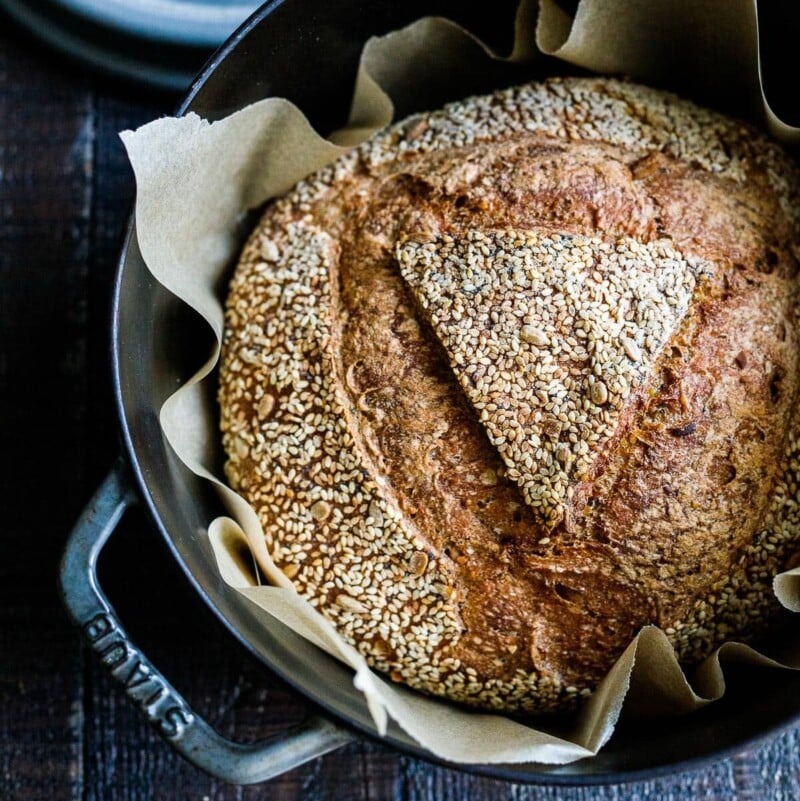
Easy Sourdough Bread Recipe with Starter
- Prep Time: 13 hours
- Cook Time: 35 mins
- Total Time: 13 hours 35 minutes
- Yield: 1 loaf
- Category: baked
- Method: bread
- Cuisine: American
- Diet: Vegan
Description
An easy Sourdough Bread recipe that rises overnight and bakes in the morning. A simple flexible recipe made with sourdough starter, that can be adapted to your needs. View the 3 instructional videos above for more details. If you don’t see the videos, make sure your ad blocker is off.
Ingredients
- 4 cups organic white bread flour, spooned and leveled (520 grams total flour) -please don’t include the bowl’s weight. I highly recommend weighing the flour for the first few loaves. (See notes for adding other types of flour.)
- 2 teaspoons fine sea salt (12 grams)
- 1 7/8 cups water (385 grams)
- 90 grams homemade sourdough starter or store-bought starter (1/3 cup) fed 8-12 hours earlier, using it slightly after peaking (For a more “sour” taste, use an unfed starter, 4-6 days after feeding if refrigerated- see notes.)
Optional additions:
- rice flour (my favorite for dusting a banneton).
- Seeds for flavoring: fennel seeds, chia seeds, flax seeds, caraway seeds, sesame seeds, poppy seeds, dill seeds, celery seeds, nigella seeds, etc. (optional, but tasty) My favorite is 1 teaspoon fennel seeds, 1/2 teaspoon caraway and 1 tablespoon chia seeds
- Substitute 1/2 cup rye flour, spelt flour or whole wheat flour or other whole-grain flour for 1/2 cup of the white bread flour if you like- resisting the temptation to add more for your first few loaves. (62 grams max).
- Add herbs (fresh or dried- rosemary, thyme, sage, etc).
- Add nuts, olives, garlic, dried fruit or cheese (please see this Rosemary Olive Sourdough Bread Post, for more “how-to” instructions).
Instructions
- 8 am. Twelve hours before mixing your dough, feed your sourdough starter, leaving it out on the counter making sure it doubles in size within 6 hours. (See notes for extra sour). OR, if you keep your starter in the fridge and fed it in the last 7 days- it is OK to use it straight from the jar, cold, without feeding. Best to use starter after it peaks, when it is “hungry”.
- 8:00 pm PLEASE use a kitchen scale if this is your first loaf. Weigh the flour in a medium bowl (***zero-ing out the weight of the bowl). Then add salt, spices, seeds. Mix starter and water in a small bowl until cloudy and well mixed. Pour the starter-water into flour incorporating all the flour using a fork or wood spoon. It should be a thick, shaggy, heavy, sticky dough. See video. Mix for about 1-2 minutes using the wood spoon- it will be hard to mix. Don’t worry about tidy dough here, just get the flour all mixed in and cover with a wet kitchen towel and let rest 15 minutes. It will loosen up as it rests. (Alternatively, mix starter and water in the bowl first, then add the salt and flour-like in my 3rd video- either way works.)
- 8:20 pm: Do the first set of stretches and folds. (See the 1st video in post) With one wet hand (put a bowl of water next to you) pull the dough from one side and stretch it upward, then fold it up and over to the center of the dough. Quarter turn the bowl and repeat, stretching up and folding it over the middle, repeat for about 30 seconds or until the dough gets firm and resists. This helps strengthen the gluten. Cover, rest, and repeat the process 15 minutes later. With wet fingers, stretch up and fold over, turning, repeating, for 30 seconds until the dough gets firm and resists. Then turn the dough over in the bowl. Yes, you could do this a couple more times if you would like to build the gluten, but not imperative. 🙂
- 8:35 pm Proof overnight, at room temp. Cover the bowl with plastic wrap, wax wrap, or a damp kitchen towel (to keep the moisture in) and place it on your kitchen counter for 8-12 hours. (see notes on temperature) 68-70F is the ideal temp. (If it is warmer, check at 6-8 hours. If it is very cold, it may take up to 18 hours in winter.)
- 6-8 AM Check the dough in the morning. The dough should have expanded, with a slight springy dome to the top. It won’t necessarily double in size ( maybe 1.5 -1.75 times bigger) but will have expanded. Do the POKE TEST: With a floured finger, poke into the dough. If it indents easily and mostly springs back to its original shape, it has probably risen enough. If it feels firm or very hard to indent, let it rise longer. If it feels loose, runny, or indents too easily or doesn’t spring back, it is most likely over-proofed (bake it anyways).
- Line a high-sided bowl with parchment. This brand of parchment does not stick to the bread- but if you are unsure about yours, spray oil your parchment lightly before putting the dough in it. (If you are a seasoned bread baker, you do not actually need parchment -this is only for easier transport only, bread will not stick to the inside of a dutch oven.) I like using a high-sided medium-sized bowl versus a flat or shallow bowl to help shore up the sides. You can also use a rice-floured Banneton (bread proofing basket) if you have one.
- 2nd Set of STRETCH and SHAPE : (Watch 2nd video -Stretch and Shape video). Loosen the dough from the all edges of a bowl with using your wet fingers, a wet spatula or wet plastic dough scraper, sliding down the sides of the bowl. With both wet hands, carefully pull the dough straight up, in the middle and lift it, stretching straight up in the air- about 1-2 feet (see photo) and place it back down, gently folding it on top of itself. In this first stretch, the dough may feel quite loose and runny. This is OK. It should firm up as it stretches and folds. (Note: If your dough breaks here, it is probably over-proofed, bake it anyways. If your dough won’t stretch like the photo and feels too tight or firm, it needs to proof longer). After the first stretch, give the bowl a quarter turn, wait 30-60 seconds, wet your hands again and stretch it up high again, folding over itself in the bowl. Wait 30-60 seconds. (You could repeat this one more time, 15 minutes later). Then, the third time you lift and stretch, you will lift it all the way into your parchment-lined bowl, folding over itself like you’ve been doing. (Alternatively, lift it into your floured proofing basket seam side up. ( If seam up, pinch the seam closed). Sprinkle top with seeds and flour (get the sides too) gently rubbing it to even coat –and add seeds if you like. If using a banneton, sprinkle the seeds in the banneton before adding the dough.
- FINAL RISE and PREHEAT OVEN: Place the bowl in the refrigerator for one hour uncovered which will firm up the bread, and make scoring easier and help boost “oven spring”. It won’t rise in the fridge. (You could also keep it in the fridge for 3-4 hours if you want to bake later.) Preheat the oven (for 1 FULL hour) to 500F with your dutch oven inside and lid on (see notes). If you have convection- use it. You can also bake the bread at 45oF or 475F. You want your oven as hot so don’t skimp on the preheat. I usually preheat for 1 full hour.
- SCORE & BAKE When ready to bake, place dough by the stove. Pull out the dutch oven, close the oven, remove lid. Score the bread in the bowl, using a very sharp knife, lame, razor blade, (or try scissors dipped in cold water), score the dough swiftly and deeply, at a 45-degree angle, 3/4- 1-inch deep. One deep slash is just fine. Or criss-cross, or crescent shape. (Or feel free to add other designs, for ideas -google “scoring bread”). You want to score where you want the dough to puff out from. You can also cut with wet kitchen scissors. Carefully lift the parchment by the corners and place both bread and parchment directly into the dutch oven. Cover quickly. It is OK if parchment peaks out. You want to score and transfer as quickly as possible. (Alternately, if using a proofing basket, cover the basket with parchment, carefully flip the dough into the parchment in the palm of your hand and then center the parchment and dough into your dutch oven, then score).
- BAKE. Place dutch oven in the middle of the 500F oven for 20 mins with convection on, 25 minutes w/no convection (or 28 minutes at 450F). Remove lid. It should be puffed and just lightly golden and internal temp close to 200F (if not, put lid back on for a few more minutes). Lower heat to 450 F, continue baking 10-15 minutes until deeply golden and internal temp reaches 204- 208F. No pale loaves please, let them get golden! (For a less “crusty” loaf, increase covered baking time, lower uncovered baking time. You can play with this for desired results.)
- COOL: It will smell heavenly. Remove from the dutch oven, let it cool 1 hour on a rack or tilted up on its side, before slicing so you don’t let the steam out and don’t smash it- be patient. This is the hardest part. 😉. Take a picture! Feel proud. You did it!
- SERVE: This type of bread is always BEST, served toasted! Then lather it with butter, ghee or olive oil. Add mashed avocado and salted tomatoes, almond butter, honey or jam. A piece of toast can turn into a great meal. See this Mushroom Toast!
- STORE: Store the bread wrapped in a kitchen towel for the first day or two to keep the crust nice and crispy, then move it to a zip lock bag to keep it moist for longer. Bread can also be sliced and frozen. Make sourdough croutons with leftover bread- great in salads and soups!
Notes
Sourdough starter : Using your starter after its peak will ensure your bread rises sufficiently. Make sure your starter is healthy, hungry, and strong, able to double in size 4-8 hours after feeding. If you store your starter in the fridge and last fed it over a week ago, make sure to feed the morning before making bread. If it has only been 3-7 days since last feeding (and you keep it in the fridge), it is OK to make bread without feeding. Use a 1/3 cup starter for your bread dough and place the remaining back in the fridge and feed a week after the last feeding. BUT if it has been a week after your last feeding, pull it out of the fridge, discard (or save for pancakes, waffles, or give away) all but 1/2 cup. Feed it. Let it metabolize the flour 4-8 hours before mixing up the bread dough. Use a 1/3 cup of starter (90 grams) for the bread, place the remaining back in the fridge, and feed in a week. For a more “sour” flavor, use starter that has been in the fridge 4-6 days. Do not feed before using it. The sourdough starter is the sourest the longer it goes without feeding.
Dutch Oven or Bread Baker: Make sure your dutch oven or bread baker can handle a 500F oven. If not, 450F will suffice, and bake 25 minutes before removing the lid. Aim for an internal bread temp of 200F when removing lid- before baking it uncovered. Take notes and adjust the next time!
NO DUTCH OVEN? If you don’t have a dutch oven, you can try baking your bread on a sheet pan, covered with a large metal bowl or pyrex bowl to keep the steam in. It will yield a flatter loaf but it does work. Bake 25-30 minutes covered, remove the bowl, bake until golden 10-15 more minutes until golden, and be sure to check internal temp with a thermometer. It may take a few practices tries to perfect this.
Smaller Loaves: If you would like to create two smaller loaves, divide after the overnight rise, shape, place in the fridge while the oven preheats and bake each at 450F for 18 minutes (or until internal temp is 200F) uncover, lower heat to 425F and bake until golden and internal temp is 204-208F. You may have to fiddle with this timing.
LOAF PAN: Yes you can bake this in a loaf pan. Shape and place it in an oiled loaf pan ( or line with parchment) for the last hour in the fridge, while oven preheats. Bake uncovered at 450 for 15 minutes, lower heat to 425 and bake another 25-ish minutes or until internal temp reaches 204-208F. You may need to play with this according to your oven. Place on middle or lower rack.
PRACTICE: As you practice making your loaves (yes, it is a fun practice) you’ll get a feel for the dough and you’ll begin to notices how changes in seasons (changes in temperature) affect the loaves and their proofing time. I suggest making the exact same loaf repeatedly several times. Warmer temps will call for shorter proofing, cooler temps, longer proofing. You can also change the proofing time by adjusting the sourdough starter amount. For a faster rise, you can add a little more starter, for example, a 1/2 or 2/3 cup. For a longer cooler rise, say in the fridge for 36-48 hours, you can reduce the starter amount to 1/4 cup or even 3 tablespoons. You can play with ratios to get the proofing time just how you want it. Take notes! You can also adjust the hydration for an airier loaf, either reducing flour or increasing water. So many variables!!! *Remember your starter and your dough are actual living “creatures” that are affected by your particular environment. The most important advice I can give you is to pay close attention to your particular “creature”, observe it carefully, and look for signs- it is communicating with you. Pay attention. 🙂 Work with it, not against it. Be patient, respond thoughtfully.
Perfecting bread is a lifelong process, and I’m still learning too. 😉
Nutrition
- Serving Size: 1 slice ( 1/12 of a loaf)
- Calories: 154
- Sugar: 0.2 g
- Sodium: 582.3 mg
- Fat: 1.1 g
- Saturated Fat: 0.2 g
- Carbohydrates: 32.7 g
- Fiber: 4.9 g
- Protein: 6 g
- Cholesterol: 0 mg
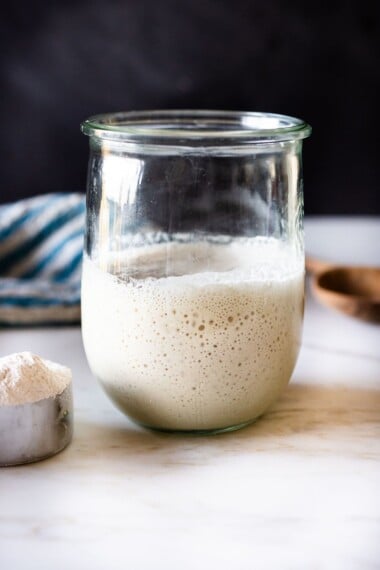
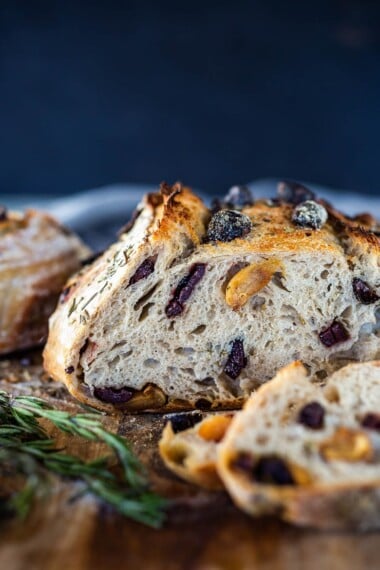









We loved this recipe! We were looking for a no knead Dutch oven bread like the one we make that uses commercial yeast, this was a winner! Perfect baking times and the crust is amazing.
I have a wonderful recipe for crusty bread. I would love to use it but replace the yeast with my starter. How much should I use? My recipe calls for 1/2 teaspoon of fast rising yeast.
Thank you so much. Your videos are very helpful!
Hi Anne, it doesn’t translate as simply as that (replacing one for the other). There are so many variables- rising time, flour to water ratio’s and so on…
I googled my question…. should have done it before I guess… answer is: A quick rule to adapt recipes to sourdough is: Substitute 1 cup of starter for each package of yeast, and then subtract about 1/2 cup of water and 3/4 cup of flour from the recipe to compensate for the water and flour in the starter.
Thanks Annie. If you try this will you let me know how it goes- also note rising times? thanks.
Absolutely! 😊
Love this recipe! The weight for the starter doesn’t change between X1, X2, or X3 – is 90 grams the correct weight for each variation? I noticed the cup measurements change but the grams don’t!
NO, the multiplier does not work, so manually calculate.
I’m fairly new to sourdough bread making.. I’ve used my starter to whip out other things before, but a full loaf is a new foray. Your recipe is thoughtfully explained and makes following along just a breeze. Just popped my first loaf out of the oven this morning and cant wait to get home from work to check out the crumb. I would LOVE to hear you explain variations for additions to a plain dough if you have any.. there’s so many different suggestions out there for how to deal with additions like seeds, fruit, spices, etc. but I feel like you explain things so well, I might be able to skip the failed attempts if I learn with you!
Hi Micah- I will add a new recipe soon, to include these! Thanks!
I agree with Micah! Sylvia, please share with us more detailed recipes on how to make a variety of breads (Olive bread, garlic bread, etc.). For example, when making olive bread, the olives bring in a lot of moisture … so we have to compensate for that, right? Again. thanks!
I will post a recipe soon!
Dear Sylvia,
Thank you so much for this recipe and detailed videos. Best success I’ve had with bread so far …
Quick question: if you want to use garlic or olives in this recipe, when do you add them in the dough?
Again thank you for sharing so much. We have been plant-based since mid-February and can’t wait to try some of your recipes. I just discovered your amazing website.
I would just add when you mix up the dough. You CAN add at the second set of stretch and folds but I use a different technique- laying the dough on a floured surface, flatten gently into a rectangle. Add fillings, then fold up like a tri-fold envelope, let rest, fold again, then shape from there.
Hi Sylvia,
I am making my own starter using your directions and have ordered a dutch oven. I just realized that the dutch oven is only safe to 400. Am I able to bake the sourdough longer at this temp or is it too low? Thanks!
I think it is too low. Im so sorry. It must be the handle? Is it plastic?
I’m not one to comment on recipes (first time!) but I have to say that this is probably the best recipe of any kind I have ever found on the Web and certainly, following this will turn out a great loaf every time. Wonderful, thank you!!
thanks so much Michael- glad it is working for you!
Awesome recipe thanks so much…
I’m struggling with shaping as I’ve gone to 85% hydration..
Yesterday the dough seemed to almost be over proofed after only 5 hrs.
Did 3 sets of lift and folds 20 min apart and it still was hard to hold its shape.so not ready for the bennaton.
Placed it in the fridge for a few hours and did a few more stretch and folds.
It still wasn’t really firming up so I’ve stuck it back in the fridge.
Any ideas on how to get the shaping part down at 85%?
Hey Todd, So I’ve never got it up that high. I’m still learning. What is your kitchen temp, just curious? That seems so fast!
Kitchen temp is around 74. Yes I thought that was fast too. Can send a pic. If you tell me where to send it.
sylvia@feastingathome.com
Hi there,
Thanks
For
Your recipe I am in Australia and gave this one a good go. Has taken me a bit to get the measurements right with the conversion but the two
Loaves I have made this far are great.
How can get I get my loaves to be more sour??
Thanks
The longer the starter goes without feeding, the more sour the bread. Use on day 4-6 after feeding ( if kept in the fridge).
Dear Sylvia, How are you not one of the most famous cooks in the world already?
Ive made so many recipes of yours and they are always perfect!
In this recipe I have added too much water because my scale was acting out weird. My dough was as liquid as my starter and sticking to the bowl, despite this I tried to perform all steps as listed in the recipe. I took much effort to slice a pattern in the dough after putting it in de fridge while heating up the oven and oiling my knife. Although it still looked very sticky and wet I just baked it. My oven could only go up to 230 celcius (20 degrees too low) but after a longer period of time 1 hour and 20 min or so, THE BREAD STILL TURNED OUT DELICIOUS !!! Next time I will put less water in the dough as the loaf was still a bit too moist inside after cutting it open. Nevertheless my bf and I ate it with butter and roquefort and it was still extremely good!!!!! Cant wait to bake another loaf in the coming days.
You are so sweet Louise, thank you!!! And I am so glad the bread worked for you!!! YAY.
I am so grateful for finding this recipe online. It produces delicious sourdough that the whole family enjoys eating. Thank you so much for all the details you have provided. I found this really helpful for my first attempts at making sourdough bread. I now double the recipe as I use my casserole dish with lid to bake my bread in. I’ve passed this recipe on to my Dad who is also keen to get started with making his own sourdough bread! Thank you!
YAY! Thanks so much Claire, glad it is working for you!
Hey Sylvia! Love this recipe. I noticed there are inconsistencies with the bake times and temps throughout the recipe and text. Can you please clarify and/or update the text? Thanks!
Between the post and recipe? Thanks, Rachel -I will take a look. 😉 Or can you specify where?
You nailed my schedule, I was tired of sourdough breads you start on day one and bake on day three. I use King Arthur AP and I up the flour 5% and the water to 490. I use a brotform in the am while the oven heats. I have a cast iron rectangular griddle and and a steam function in my oven so I open bake at 475 for 20 min or to 200 degrees. wonderful crust and nice bread texture. I love the stretch and fold technique. Thanks
Glad it worked for you Doug!
We LOVE this sourdough and it tastes amazing every time! Our most recent loaf was over-poofed. It is currently in the fridge so I can do the last stretch and fold before we bake. Thank you for this recipe Sylvia!
Awesome Brandon, thanks so much and glad you liked it!
Sylvia, you mentioned your bread doesn’t stick to your parchment paper. What brand parchment paper do you use?
If YOU CARE brand. 🙂
I’ve had my loaves stick to the parchment and it’s time consuming getting it scraped off to say the least. I’ve now sprayed the parchment with Pam (non-stick spray) and sprinkled cornmeal in the the bottom before placing the dough in it. Voila – perfection!
Perfect, thanks for sharing.
The easiest and best!
Amazing bread! made yesterday and it turned out yummy! dough was a bit more wet than what it looked on your video (I weighed the ingredients) so maybe next time I should up the flour a little bit. It looked good too 🙂
If my kitchen is too warm, should I do the overnight rise entirely in the fridge?
I don’t want to wake at night (early am) to check it ☺️
You could, but my guess is it will take longer than overnight in the fridge- 24-36 hours?
After multiple failed attempts at this, I realized I didn’t have the right flour nor did I have the right equipment (was using bleached flour, didn’t have a large enough baking sheet nor pot to cover it and I didn’t have a Dutch Oven but have been wanting one for ages. My Dutch Oven arrived a couple of days ago and VOILA! My first perfect sourdough loaf was born!!! I chilled a little extra in the fridge, adding a little extra flour to the top, and was finally able to score it. I think another issue I was having is my sourdough starter wasn’t really “ready”. I’ve been messing around with it for a couple of months and finally have it going – it literally tries to crawl out of the jar when I feed it…. it’s so fun to watch. I also have completely enjoyed using the sourdough discard for different recipes. Literally the sourdough pancakes are the best I’ve ever had! Also love making sourdough pizza and scones. Can’t wait to try other recipes. Thank you SO MUCH for all your encouragement and detail. I think I would’ve given up a while back if not for all of your helpful tips and hints. Oh, and Suze (my starter) says hello!
Congrats Marie- say hi to Suze!
Fantastic recipe. I sprinkled sesame seeds on my latest loaf and it tastes delicious! Such a simple recipe— I can’t believe I am baking such great bread! Thank you.
Awesome! great to hear! 🙌
Ive been using this recipe since the end of May, and every time I tried, it was a big success from the very beginning when I almost thought I failed because of the too wet dough!! ( My daughter accidentally put too much water in her hands every time she did stretch- and- fall) However, I went ahead and baked it after reading your answers of the trouble shooting at the end of the recipe, and it turned out exactly the way we wanted with soft and chewy texture!!)
Thank you so much for this forgiving and easy recipe with step-by-step instruction, and now Im ready to explore with different grains!
Perfect!Glad it worked for you! 🙌
I’ve made my first sourdough today and it come out perfect! Your recipe it’s so easy to follow! The measurements in grams are a great help as cups and Spoons sizes size in Australia are different .
Awwww thanks Eddy- and huge congrats! The BEST feeling in the world. EVER. 😉
Love this recipe. First loaf turned out fantastic! Only question: loaf was a slight bit gummier in the middle than I’d like, and crust a bit on the soft side of crusty. Though in both case within like 5% of perfect, so quite close. What should I do differently to get it dialed in? I baked at 475 in dutch oven and removed lid at same temp. Would more time or diff temps help? Or do I need to adjust water in my dough?
Try increasing heat to 500F,before lowering- and perhaps slightly more rising time?
I’ve experimented with loads of recipes. This is my new favorite… it simple to follow, low effort, and created a delicious loaf!
This bread is so easy peasy to make one might wonder how on earth can it taste sooooo good ! I have made a couple loaves with all white bread flour, a couple of loaves with whole wheat added, and today my 1st loaf with white & whole wheat & ROSEMARY. Ohhhhh my the heavenly smell in the kitchen this morning : )
I bake in a cast iron dutch oven and double the recipe so I make a nice big farm style round. I preheat the oven for 1hr at 500 on convection bake. Each loaf I have made is already browning on the edge on the top where I cut the “crescent” when I remove the lid. So when I am baking at 450 I end up tenting the bread so it won’t burn on that nice crusty crescent edge.
Should I start at 475 instead of 500?
Love this! What size Cast iron do you use, just curious? Yes, try it at 475, reduce to 450 after popping lid off.
Hi Sylvia, I have a Lodge 7 Qt dutch oven.